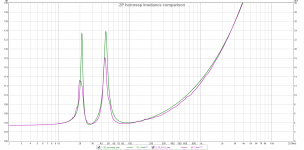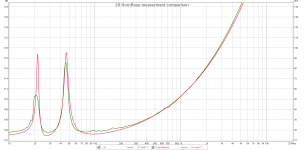I knew there was a good explanation why it didn't really matter.
Thank You
Dave
PS OK, just wondering why one may have linear actuators on an amp rack
In my whole life I've never been enthused about an isobaric, but the more that I look at how the parameters function, the more I see that going isobaric has a lot of advantages. As I see it, the trick is NOT to focus on the fact that box size is halved. Instead I'd focus on the fact that the motor strength has increased. (bl / sqrt (re))
For instance, if there's a big peak in the output the additional motor strength will reduce the bump at the driver's FS, and improve transient response in the process.
Of course, all of these advantages make more sense if you're not going for a sealed box.
If there is a peak at Fc, then Qtc of the system is higher 0.707 and we approached to the fact of halved space from other side
The biggest advantage, I noticed, is that the amount of suspension noises is decreased because of the second speaker is isolated from listener. So, two fine speakers in isobaric configuration sound a bit more musically than one with strong motor and with coarse suspension.
The biggest advantage, I noticed, is that the amount of suspension noises is decreased because of the second speaker is isolated from listener. So, two fine speakers in isobaric configuration sound a bit more musically than one with strong motor and with coarse suspension.
In my whole life I've never been enthused about an isobaric, but the more that I look at how the parameters function, the more I see that going isobaric has a lot of advantages. As I see it, the trick is NOT to focus on the fact that box size is halved. Instead I'd focus on the fact that the motor strength has increased. (bl / sqrt (re))
For instance, if there's a big peak in the output the additional motor strength will reduce the bump at the driver's FS, and improve transient response in the process.
Of course, all of these advantages make more sense if you're not going for a sealed box.
I'm experimenting with isobaric for the motor strength. This thread is most interesting.
Seems more appropriate to bring a thread back from the dead rather than start my own. As the previous discussion is just based on identical drivers and such like, yet in the real world there is always mismatch and loss.
Basically I have built and isobaric bass reflex box. For testing I have wired the two dvc drivers in parallel with their voice coils in series and clamped the side of the box on to check the tune. In actual use I will wire the drivers in series.
Attached is the measured box impedance compared to the simulated box impedance for the parallel configuration. I believe it shows that mismatch between the resonant frequencies of the two drivers is misshaping the resonant peaks. Also probably as hornresp doesn't include any port losses I would expect the peaks to be a bit lower in real life as well.
Waiting for glue to set at the moment but I would expect that a series configuration is going to not have less distortions as the drivers are fundamentally current mode devices and it enforces current sharing.
Basically I have built and isobaric bass reflex box. For testing I have wired the two dvc drivers in parallel with their voice coils in series and clamped the side of the box on to check the tune. In actual use I will wire the drivers in series.
Attached is the measured box impedance compared to the simulated box impedance for the parallel configuration. I believe it shows that mismatch between the resonant frequencies of the two drivers is misshaping the resonant peaks. Also probably as hornresp doesn't include any port losses I would expect the peaks to be a bit lower in real life as well.
Waiting for glue to set at the moment but I would expect that a series configuration is going to not have less distortions as the drivers are fundamentally current mode devices and it enforces current sharing.
Attachments
- Status
- This old topic is closed. If you want to reopen this topic, contact a moderator using the "Report Post" button.

